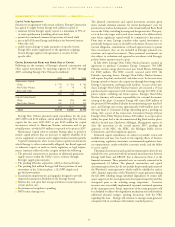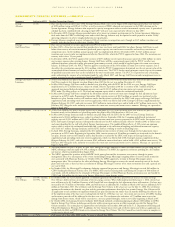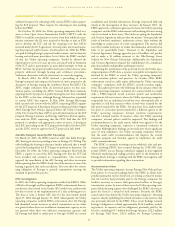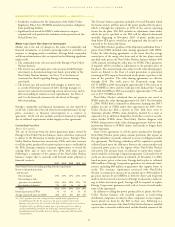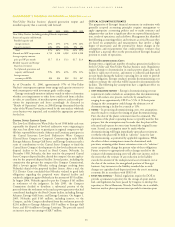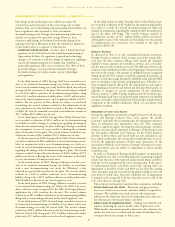Entergy 2006 Annual Report Download - page 59
Download and view the complete annual report
Please find page 59 of the 2006 Entergy annual report below. You can navigate through the pages in the report by either clicking on the pages listed below, or by using the keyword search tool below to find specific information within the annual report.
ENTERGY CORPORATION AND SUBSIDIARIES 2
2000066
■Establishes conditions for the elimination of the Public Utility
Regulatory Policy Act’s (PURPA) mandatory purchase obligation
from qualifying facilities.
■Significantly increased the FERC’s authorization to impose
criminal and civil penalties for violations of the provisions of the
Federal Power Act.
MARKET AND CREDIT RISK SENSITIVE INSTRUMENTS
Market risk is the risk of changes in the value of commodity and
financial instruments, or in future operating results or cash flows, in
response to changing market conditions. Entergy holds commodity
and financial instruments that are exposed to the following significant
market risks:
■The commodity price risk associated with Entergy’s Non-Utility
Nuclear business.
■The interest rate and equity price risk associated with Entergy’s
investments in decommissioning trust funds, particularly in the
Non-Utility Nuclear business. See Note 17 to the financial
statements for details regarding Entergy’s decommissioning
trust funds.
■The interest rate risk associated with changes in interest rates
as a result of Entergy’s issuances of debt. Entergy manages its
interest rate exposure by monitoring current interest rates and its
debt outstanding in relation to total capitalization. See Notes 4
and 5 to the financial statements for the details of Entergy’s
debt outstanding.
Entergy’s commodity and financial instruments are also exposed to
credit risk. Credit risk is the risk of loss from nonperformance by sup-
pliers, customers, or financial counterparties to a contract or
agreement. Credit risk also includes potential demand on liquidity
due to collateral requirements within supply or sales agreements.
Commodity Price Risk
Power Generation
The sale of electricity from the power generation plants owned by
Entergy’s Non-Utility Nuclear business, unless otherwise contracted,
is subject to the fluctuation of market power prices. Entergy’s Non-
Utility Nuclear business has entered into PPAs and other contracts
to sell the power produced by its power plants at prices established in
the PPAs. Entergy continues to pursue opportunities to extend the
existing PPAs and to enter into new PPAs with other parties.
Following is a summary of the amount of the Non-Utility Nuclear
business’ output that is currently sold forward under physical or
financial contracts:
2007 2008 2009 2010 2011
Non-Utility Nuclear (including pending Palisades acquisition):
Percent of planned generation
sold forward:
Unit-contingent 43% 45% 36% 23% 23%
Unit-contingent with
guarantees of availability(a) 45% 36% 28% 22% 7%
Firm liquidated damages 7% 4% –% –% –%
Total 95% 85% 64% 45% 30%
Planned generation (TWh) 38 41 41 41 41
Average contracted price per MWh $49 $53 $57 $53 $47
(a) A sale of power on a unit contingent basis coupled with a guarantee of
availability provides for the payment to the power purchaser of contract
damages, if incurred, in the event the seller fails to deliver power as a result of
the failure of the specified generation unit to generate power at or above a
specified availability threshold. All of Entergy’s outstanding guarantees of
availability provide for dollar limits on Entergy’s maximum liability under
such guarantees.
The Vermont Yankee acquisition included a 10-year PPA under which
the former owners will buy most of the power produced by the plant,
which is through the expiration in 2012 of the current operating
license for the plant. The PPA includes an adjustment clause under
which the prices specified in the PPA will be adjusted downward
monthly, beginning in November 2005, if power market prices
drop below PPA prices, which has not happened thus far and is not
expected in the foreseeable future.
Non-Utility Nuclear’s purchase of the Fitzpatrick and Indian Point 3
plants from NYPA included value sharing agreements with NYPA.
Under the value sharing agreements, to the extent that the average
annual price of the energy sales from each of the two plants exceeds
specified strike prices, the Non-Utility Nuclear business will pay 50%
of the amount exceeding the strike prices to NYPA. These payments,
if required, will be recorded as adjustments to the purchase price of
the plants. The annual energy sales subject to the value sharing agree-
ments are limited to the lesser of actual generation or generation
assuming an 85% capacity factor based on the plants’ capacities at the
time of the purchase. The value sharing agreements are effective
through 2014. The strike prices for Fitzpatrick range from
$37.51/MWh in 2005 increasing by approximately 3.5% each year to
$51.30/MWh in 2014, and the strike prices for Indian Point 3 range
from $42.26/MWh in 2005 increasing by approximately 3.5% each
year to $57.77/MWh in 2014.
Non-Utility Nuclear calculated that no payment was owed to
NYPA under the value sharing agreements for 2005. On November
1, 2006, NYPA filed a demand for arbitration claiming that $90.5
million was due to NYPA under these agreements for 2005. Non-
Utility Nuclear has filed a motion in New York State court to
determine whether NYPA’s claim should be decided by a court as
opposed to by an arbitrator. Regardless of whether a court or an arbi-
trator decides NYPA’s claim, Non-Utility Nuclear disagrees with
NYPA’s interpretation of the value sharing agreements, believes it has
meritorious defenses to NYPA’s claims, and intends to litigate those
claims vigorously.
Some of the agreements to sell the power produced by Entergy’s
Non-Utility Nuclear power plants contain provisions that require an
Entergy subsidiary to provide collateral to secure its obligations under
the agreements. The Entergy subsidiary will be required to provide
collateral based upon the difference between the current market and
contracted power prices in the regions where Non-Utility Nuclear
sells power. The primary form of collateral to satisfy these require-
ments would be an Entergy Corporation guaranty. Cash and letters of
credit are also acceptable forms of collateral. At December 31, 2006,
based on power prices at that time, Entergy had in place as collateral
$810 million of Entergy Corporation guarantees for wholesale trans-
actions, including $88 million of guarantees that support letters of
credit. The assurance requirement associated with Non-Utility
Nuclear is estimated to increase by an amount up to $303 million if
gas prices increase $1 per MMBtu in both the short- and long-term
markets. In the event of a decrease in Entergy Corporation’s credit rat-
ing to below investment grade, Entergy will be required to replace
Entergy Corporation guarantees with cash or letters of credit under
some of the agreements.
In addition to selling the power produced by its plants, the Non-
Utility Nuclear business sells installed capacity to load-serving
distribution companies in order for those companies to meet require-
ments placed on them by the ISO in their area. Following is a
summary of the amount of the Non-Utility Nuclear business’ installed
capacity that is currently sold forward, and the blended amount of the
MANAGEMENT’S FINANCIAL DISCUSSION and ANALYSIS continued
43


